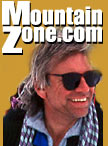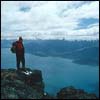Hiking In New Zealand
South Island
February 4, 2002
| |||
From Auckland, most mountain lovers head to the South Island. A two hour flight from Auckland took me to Queenstown, a small, positively humming city nestled by the shore of Lake Wakatipu, in the very shadow of a range of mountains called the Remarkables ("the Remarx" to the locals). Remember those fairy tale mountains you saw in Lord of the Rings? Those were the Remarx. In fact, part of the fun of being here is seeing how director and native son Peter Jackson utilized New Zealand's unbelievable scenery to make his fantasy movie come alive.
Queenstown is a hub for outdoor activity on the South Island. Think of the place as the Jackson Hole or Chamonix of New Zealand, a city so enjoyable despite it's unabashedly commercial orientation that Conde Nast Traveler rates it among the top ten cites in the world. The well-practiced informality of this town reflects the fact it is all about having fun. Whether you're looking for a gas canister for the stove, a guide service or a topo map, maybe a jet-boat excursion or a helicopter ride, you'll find everything within a block or two. Its popularity with foreign visitors means there's food and lodging across the range of possibilities. For the traveler in this berg, the living is easy.
The Milford Track may be the best known of all the Great Walks, perhaps the most famous hike in the country. This amazing four day backcountry trip extends for 54 kilometers from the northern end of Lake Te Anau, to Sandfly Point near Milford Sound. Renowned for its glacially carved valleys, alpine flowers and waterfalls, the highlight of this route remains its destination: the incomparable Milford Sound, a true fiord impossibly nestled among the snow-capped peaks of the coastal mountains on the Tasman Sea. Day three ascends Mackinnon Pass, a high alpine route that provides an unforgettable climax to the track before it descends to the shores of the sound.
| "Slightly shorter than the Milford, and less popular, the Routeburn is an alpine journey of unbelievable grandeur and variety." |
|||||
Memories that linger include long grades up through the moss-covered beech forests, or rounding a corner to see down the long Hollyford Valley all the way to the Tasman Sea shimmering between the peaks. This is home to the kea, an alpine parrot prone to comic behavior, swooping overhead, making a racket, hoping for a hand out at lunch stops. So appealing was this walk, so varied the landscape, that when me and my companions reached the end of this glorious walk we felt like turning around and doing it again.
The Milford, Routeburn and nearby Hollyford Track make a delicious sampler of New Zealand backcountry, and a good introduction to how it's done down here. The hiking styles of this country are unique. Independent hikers (called "freedom walkers") simply need permits from the Department of Conservation to hike the tracks from hut to hut. The huts on all the Great Walks and most of the popular routes are quite comfortable, many with coal-fired heating stoves and even gas stoves for cooking. It's a civilized arrangement that makes for a light pack, though it takes some getting used to by North American backcountry types accustomed to pitching tents.
Hikers who want to travel to New Zealand but don't relish taking all that backcountry gear along can sign up for the guided-hiking options for both the Milford Track and the Routeburn Track. These hikers have gear provided, stay in more comfortable lodges, and enjoy meals prepared by the guides.
The hiking down here can be as wild or as comfortable as you want it. True wilderness jaunts can be found further south, near the extremities of Fiordland National Park and beyond, on Stewart Island. Once you're here, experienced, well equipped backpackers can choose between wild costal and mountain trails that see very little traffic--but still enjoy the security of huts when ferocious southern storms roll in. Many of these rustic shelters date from the 1930s, and make what can be wet and wild conditions bearable.
| |||
How to "do" Queenstown is a matter of personal style. With tourists from all over the world, accommodations and restaurants come in all flavors, from backpackers' hostels to five star luxury hotels. I chose the middle ground: a comfortable place called the Dairy Guesthouse, a former general store that combines the best features of a hotel and a bed and breakfast, with large rooms and private baths. The couple who ran the guesthouse graciously accommodated my ridiculous schedule (gone for a few days, back for a few days, out at the crack of dawn, etc), and stored my humongous duffle bags without complaint during my absences. The place felt like home, and the big breakfasts kept me going most of the day.
Wanting to avoid the hassle of a car, I chose accommodations with location in mind--minutes from anywhere, yet out of the bustle of downtown. Guy Cotter drove over from Wanaka one day to meet me for beer at his favorite pub, The Lone Star, and a half block walk took me there. Cotter, one of New Zealand's best known Himalayan climbers, took over Adventure Consultants after Rob Hall's death in 1996. His company offers guided trips from Mount Cook to Mount Everest and peaks in between. Cotter spun funny stories about his recent job rigging the rappels at for the adventure race on Fiji, and about doing "safety" for the crew of the film Vertical Limit, filmed in part at a nearby ski area. Over a Mac's Gold he described how a swarm of moths attracted to the propane lanterns comicallycomplicated the famous K2 base camp "party" scene.
| "This issue of beer is no small matter, as the excellent brews of New Zealand make for some daunting choices." |
|||||
Winnie Bagoes is probably the current hip place in town. In the evening, it's a raucous and rowdy and crowded joint with great music, as I learned when my trail companions and I celebrated completion of a three-day backcountry trip there. But it was a few days later, in the quiet of a late afternoon when I stopped in for a pizza, that the waitress informed me the roof of the place opened. "Sure," I said, thinking maybe she meant the skylights or something. Sensing my skepticism, she said, "No, really," and had the bar tender flip the switch, setting a couple of giant hydraulic actuators to whirring. Soon, the entire pitched roof cranked open-wide open--like the jaws of a dragon, letting in some low overcast along with a few serious snow flurries. The other patrons just laughed and moved a little closer to the fireplace. Time after time, I found New Zealand was like that, quirky and fun, no bummers allowed. "Good as gold," as the Kiwis are fond of saying.
— Peter Potterfield, MountainZone.com Staff




